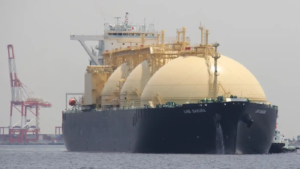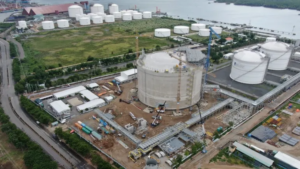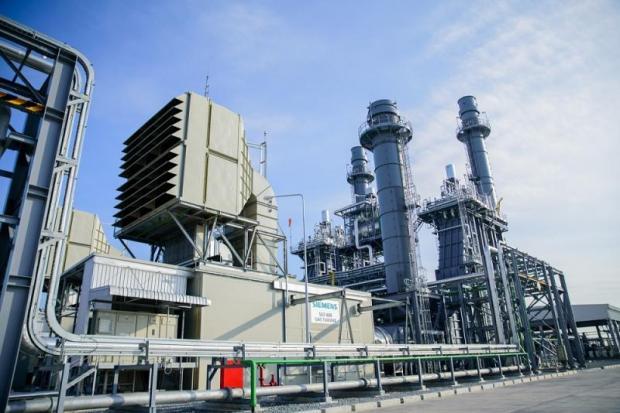
Vietnam turns to LNG power plants, seeking to shake coal dependence
Rising prices loom over Southeast Asia’s growing appetite for natural gas
Liquefied natural gas is entering the spotlight in Vietnam as the country tries to wean itself off carbon-intensive coal, keeping pace with a growing regional trend that could be tripped up by intensifying competition for the fuel.
Samsung C&T and Vietnamese construction company Lilama announced in March a $940 million engineering, procurement and construction contract for what is expected to be the country’s first LNG-fueled power plant. The 1,500-megawatt facility will be operated by PetroVietnam Power, a unit of state-run Vietnam Oil and Gas Group, and is slated to come online in 2024 or 2025.
Vietnam now generates roughly half its electricity from coal, which is usually cheaper and more accessible than other fuels. But its high carbon footprint is not compatible with Prime Minister Pham Minh Chinh’s pledge last November to achieve net-zero emissions by 2050.
The ruling Communist Party remains resolute against nuclear power after scrapping plans for Japanese- and Russian-backed plants in 2016, while output from renewable sources like solar and wind tends to fluctuate. LNG — which, although a fossil fuel, generates about half the emissions of coal when burned — is seen as a more promising route to cutting back on carbon.
The country has more than 20 LNG-fired power plants in the pipeline nationwide, according to local media reports. Tokyo Gas and Japanese trading house Marubeni plan to build a 200 billion yen ($1.5 billion) facility in the province of Quang Ninh near Hanoi, and Japanese energy group JERA is eyeing an LNG power plant and terminal in northern Vietnam.
More than half of these projects have yet to specify a source for the fuel. “The U.S. will be a leading candidate,” an industry insider predicted. Washington has previously pressured Hanoi to reduce its trade surplus with the U.S., and maintaining good relations is a priority for the Vietnamese government.

LNG is on the rise elsewhere in Southeast Asia as well. In the Philippines, First Gen, an energy subsidiary of real estate conglomerate Lopez Group, is partnering with Tokyo Gas on an offshore LNG terminal that is due to begin receiving the fuel as early as this year.
A number of companies have entered the field in Thailand since the country started importing LNG in 2011. Gulf Energy Development, a major local utility, and Japanese trading house Mitsui & Co. are building a 2,500 MW natural gas and LNG power plant. The 175 billion yen facility is set to begin operating in 2023, supplying power to the Electricity Generating Authority of Thailand under a 25-year contract.
Amid this trend, there is mounting concern in the region over skyrocketing fuel prices. Asian LNG spot prices have surged roughly fivefold over the past year, owing partly to Russia’s invasion of Ukraine. And with much of Europe turning to LNG as an alternative to gas piped in from Russia, many do not see prices returning to earlier levels anytime soon.
In this sellers’ market, new Southeast Asian power providers are likely to get stuck in unfavorable contracts with suppliers. Offsetting these high prices with rate increases may prove difficult. “The hurdles to passing prices on to consumers are relatively high” compared to economically stronger markets like Europe, Japan and China, a power industry source said.
With resource nationalism on the rise worldwide, Southeast Asian economies with less economic clout than rival buyers may struggle to secure a stable supply of LNG.
The number of economies in Asia-Pacific that import LNG has doubled over the last 10 years, and the region now consumes more than 70% of the fuel. Deliveries to China in particular have risen sharply. Last year, China surpassed Japan to be the top LNG importer.
Chinese LNG imports jumped 18% to roughly 81 million tons, according to British researcher IHS Markit. Japan had led the import market since the early 1970s, but the volume remained flat at about 75 million tons in 2021. South Korea was third at approximately 46 million tons that year.
China, India, Japan, South Korea and Taiwan were the only Asia-Pacific importers of LNG in 2010, according to statistics from BP. That roster has since expanded by four more countries as of 2020, along with an “other Asia-Pacific” entry. The region’s share of imports jumped from 60% in 2010 to 71% in 2020.
The Association of Southeast Asian Nations, which is home to more than 650 million people, is on track to drive LNG imports going forward along with South Asia. Many countries in the two regions need to feed growing demand for electricity despite diminishing natural gas production.
Source: https://asia.nikkei.com/Business/Energy/Vietnam-turns-to-LNG-power-plants-seeking-to-shake-coal-dependence


